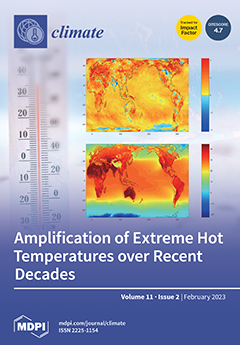Open AccessEditor’s ChoiceArticle
Heatwave Variability and Structure in South Africa during Summer Drought
by
Innocent L. Mbokodo, Mary-Jane M. Bopape, Thando Ndarana, Sifiso M. S. Mbatha, Tshimbiluni P. Muofhe, Mukovhe V. Singo, Nkosinathi G. Xulu, Tumelo Mohomi, Kingsley K. Ayisi and Hector Chikoore
Cited by 11 | Viewed by 8753
Abstract
Pronounced subsidence leading to summer drought over southern Africa causes warmer than average surface air temperatures or even heatwave (HW) conditions. We investigated the occurrence of HWs during the summer drought over South Africa based on station data and the ECMWF ERA5 reanalyses.
[...] Read more.
Pronounced subsidence leading to summer drought over southern Africa causes warmer than average surface air temperatures or even heatwave (HW) conditions. We investigated the occurrence of HWs during the summer drought over South Africa based on station data and the ECMWF ERA5 reanalyses. Temperature observations from the South African Weather Service were analyzed for seasonality and long-term trends (1981–2020) as background to the occurrence and variability of HWs. We focused on three severe El Niño Southern Oscillation (ENSO)-induced drought seasons, i.e., 1982/83, 1991/92, and 2015/16, to investigate HW characteristics. While 1997/98 was among the strongest El Niño seasons, the impacts were not as severe because it coincided with an intense Angola low, which allowed for rain-bearing cloud bands to form. Results showed that the hottest months were spread across the austral summer season from December to February. Regions experiencing high mean maximum temperatures and high HW frequencies exhibited a strong ENSO signal, with record HWs occurring during 2015/16. The establishment and persistence of a middle-level high-pressure system over Botswana/Namibia (Botswana High) appears to trigger the longest-lasting HWs during drought seasons. The Botswana high is usually coupled with a near-surface continental heat low and/or tropical warm air advection towards the affected region. It was also found that intense ENSO-induced drought events coincided with high HW frequency over South Africa, such as during 1982/83, 1991/92, and the recent 2015/16 events. The results of this study contribute to understanding drought and heat wave dynamics in a region experiencing rapid warming as a result of climate change.
Full article
►▼
Show Figures





